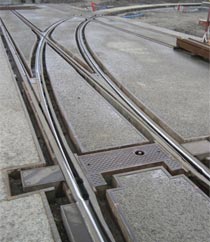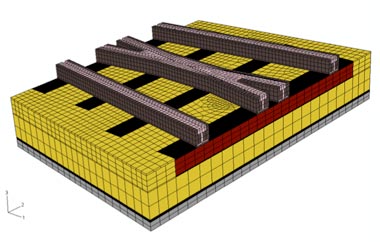TURNOUTS : New concepts for turnouts in urban rail transit infrastructure (2003-2006)
The objective of this research project was to improve vehicle-track interaction in urban rail turnouts, aiming to enhance their efficiency and safety, reduce the required maintenance costs, and restrain the emitted noise and vibration. In contrast to standard track, where train-induced vibrations are mainly related to track irregularities, the dynamic response of turnouts is dominated by the non-uniform geometry of wheel-rail contact and variations in track flexibility. Such peculiarities are responsible for the development of strong vibrations during train passage. At the point of rail intersection (heart), where a gap is unavoidable to provide the necessary wheel flange clearance, the system is subjected to severe impact loading, critical for the design and maintenance of railway tracks. Especially in the case of urban turnouts, the vibration levels are also directly related to the exerted noise nuisance. For this purpose, two different analysis methods were developed to simulate train-turnout interaction. The first was based on a multi-body model of the trainset and of wheel-rail contact, utilizing a simplified finite element model for the turnout. The second focused on the details of the turnout, which was modelled with 3-D finite elements, utilizing a simplified model to compute impact loading due to wheel passage over the flange-way gap. The two models were validated against line measurements on three different urban metro and tram networks. Then, three new turnout concepts were developed, aiming to reduce noise and vibration. Their effectiveness was first assessed numerically (using the two validated methods). Their actual performance, along with the effectiveness of the two analysis methods, was then verified through real-scale line measurements.


